How to Make Basil Oil
Are you ready to embark on a culinary adventure and learn how to make your own flavorful basil oil at home?
How to Make Basil Oil – Key Takeaways:
- Making basil oil requires fresh basil leaves and a blender or food processor.
- Blanch the basil leaves in boiling water, then transfer them to an ice water bath to retain their vibrant green color and fresh flavor.
- After drying the blanched basil leaves, blend them with a neutral flavored oil, such as grapeseed or canola oil.
- Strain the basil oil for a smoother consistency, if desired.
- Season the oil with salt to enhance its flavors, and store it in the refrigerator for 1-2 weeks.
The Essence of Basil Oil
Basil oil is a versatile ingredient that can transform your dishes with its unique and vibrant flavor. Whether you’re a seasoned chef or an aspiring home cook, incorporating basil oil into your culinary adventures can elevate your dishes to new heights. The fragrant aroma and fresh taste of basil can enhance a wide range of recipes, from salads and pastas to roasted vegetables and grilled chicken. With just a handful of ingredients and a blender or food processor, you can easily make your own homemade basil oil to add a burst of flavor to your favorite dishes.
To make basil oil, you will need fresh basil leaves and a blender or food processor. Start by blanching the basil leaves in boiling water for 10-15 seconds, then transfer them to an ice water bath. This quick process helps retain the vibrant green color and fresh flavor of the basil. Once the leaves are cooled, drain them and pat them dry to remove excess moisture. Next, place the basil in a blender with 1 cup of neutral flavored oil, such as grapeseed or canola oil. Blend until the basil is pureed and the mixture is smooth.
At this point, you can choose to use the basil oil as is or strain it through a fine mesh sieve or cheesecloth to achieve a smoother consistency. It’s important to season the basil oil with salt to taste, as this will further enhance the flavors. Finally, transfer the basil oil to a jar or container and refrigerate it. The basil oil can be stored in the refrigerator for 1-2 weeks, allowing you to enjoy its delicious taste and aromatic essence in a variety of dishes.
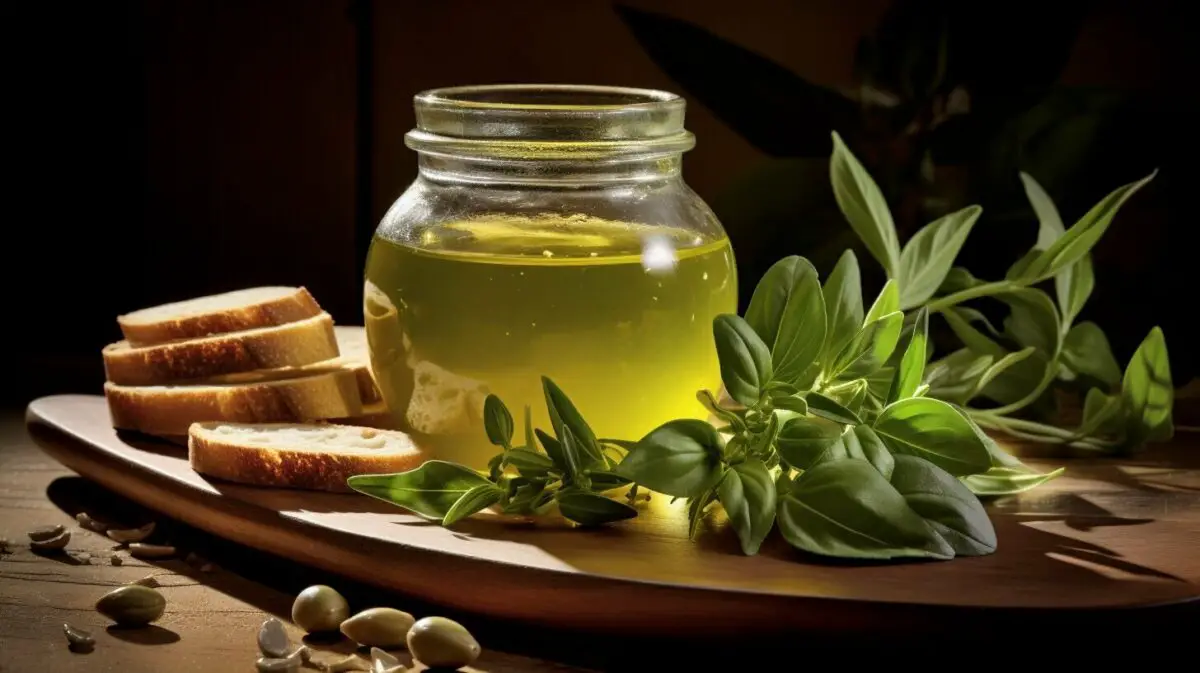
With its vibrant flavor and versatile nature, basil oil opens up a world of culinary possibilities. From marinating meats and seasoning vegetables to finishing and garnishing dishes, there are endless ways to incorporate basil oil into your cooking techniques. It can also be used to create infused dressings, flavor bread, enhance seafood and appetizers, and so much more. The health benefits of basil oil, coupled with its delicious taste, make it an essential ingredient in any kitchen. So, why not embark on a culinary journey and explore the wonders of basil oil? Your taste buds will thank you!
Gathering the Ingredients
To create the perfect basil oil, you’ll need a handful of fresh basil leaves, high-quality olive oil, and a clove of garlic for an extra burst of flavor. These simple ingredients will elevate your cooking and add a touch of freshness to your dishes.
Start by gathering a handful of fresh basil leaves. Look for vibrant green leaves that are free from any blemishes or wilting. It’s best to pick the leaves just before using them to ensure maximum flavor.
Next, choose a high-quality olive oil. Opt for extra virgin olive oil, as it has a rich and robust flavor that pairs well with the basil. The oil will act as a carrier for the basil’s aromatic compounds, infusing your oil with its delightful essence.
Lastly, add a clove of garlic to the mix. Garlic adds a subtle kick and depth of flavor to the basil oil. Peel and finely mince the garlic, or use a garlic press for convenience.
| Ingredients | Quantity |
|---|---|
| Fresh basil leaves | A handful |
| Olive oil | 1 cup |
| Garlic | 1 clove |
“Fresh basil leaves, high-quality olive oil, and a clove of garlic for an extra burst of flavor.”
Now that you have all your ingredients ready, it’s time to dive into the wonderful world of basil oil!

Blanching the basil leaves helps preserve their vibrant green color and fresh flavor. It’s a simple process that involves briefly immersing the leaves in boiling water, then transferring them to an ice water bath.
- Bring a pot of water to a rolling boil.
- Add the fresh basil leaves and blanch for 10-15 seconds.
- Using a slotted spoon or tongs, transfer the blanched leaves to a bowl of ice water.
- Let the leaves sit in the ice water bath for a minute to cool and stop the cooking process.
This blanching technique ensures that the basil leaves retain their vibrant green color, making your basil oil visually appealing.
Preparing the Basil Leaves
To preserve the bright green color and fresh taste of the basil leaves, begin by blanching them in boiling water for just 10-15 seconds, then quickly transfer them to an ice water bath. This simple process helps to lock in the vibrant flavor and prevents the leaves from turning dull or bitter.
Blanching is a culinary technique that involves submerging food briefly in boiling water and then immediately plunging it into ice water to halt the cooking process. In the case of basil leaves, this step is crucial to maintaining their visual appeal and delicate taste.
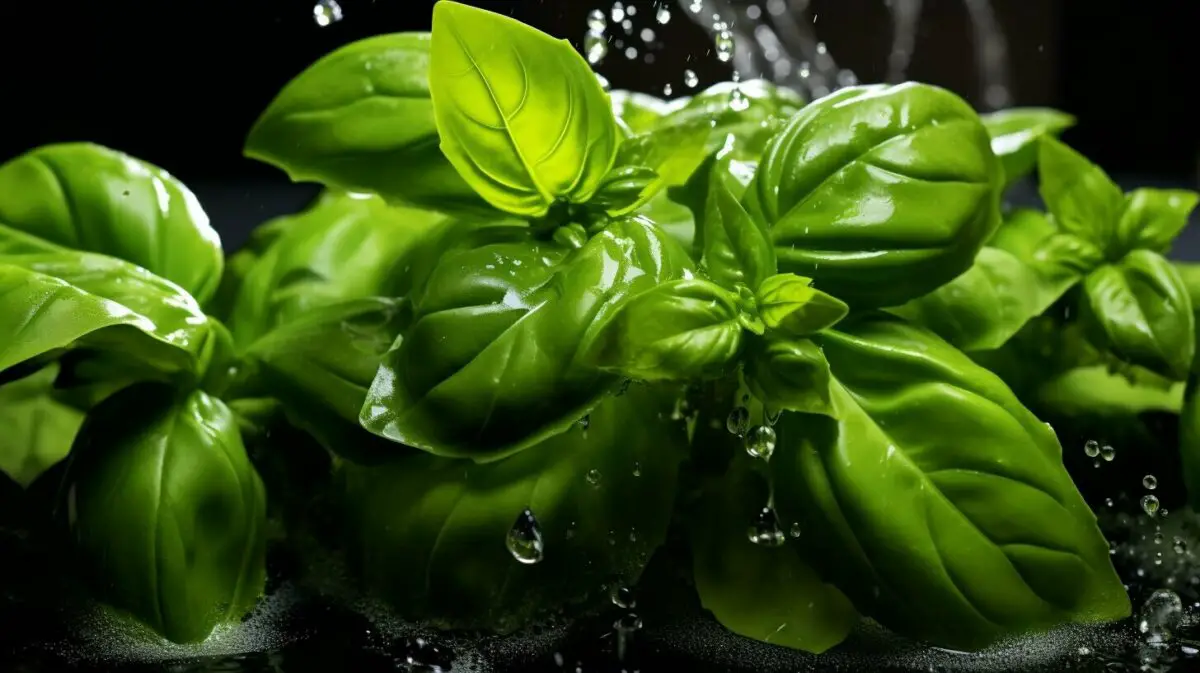
Once the basil leaves have been blanched and cooled, drain them thoroughly to remove excess moisture. Gently pat them dry with a paper towel or clean kitchen cloth. This step ensures that the basil oil will have a smooth and consistent texture when blended with the oil.
| Blanching the Basil Leaves | Drying the Basil Leaves |
|---|---|
|
|
Now that your basil leaves are blanched, dried, and ready to go, it’s time to move on to the next step: blending them with a neutral flavored oil to create your homemade basil oil.
Drying the Basil leaves
After blanching, make sure to drain the basil leaves thoroughly and gently pat them dry to remove any excess water. This step is crucial to prevent the basil oil from becoming watery and diluting its flavor. You can use a colander or a salad spinner to drain the blanched leaves. Once drained, place the leaves on a clean kitchen towel or paper towels and gently pat them dry. This will help absorb any remaining moisture and ensure the leaves are ready to be blended with the oil.
Drying the basil leaves properly is essential for achieving a vibrant green color and preserving their aromatic qualities. By removing excess water, the basil oil will have a more concentrated flavor and a smoother consistency. It is important to handle the leaves with care during this process to avoid bruising or damaging them.
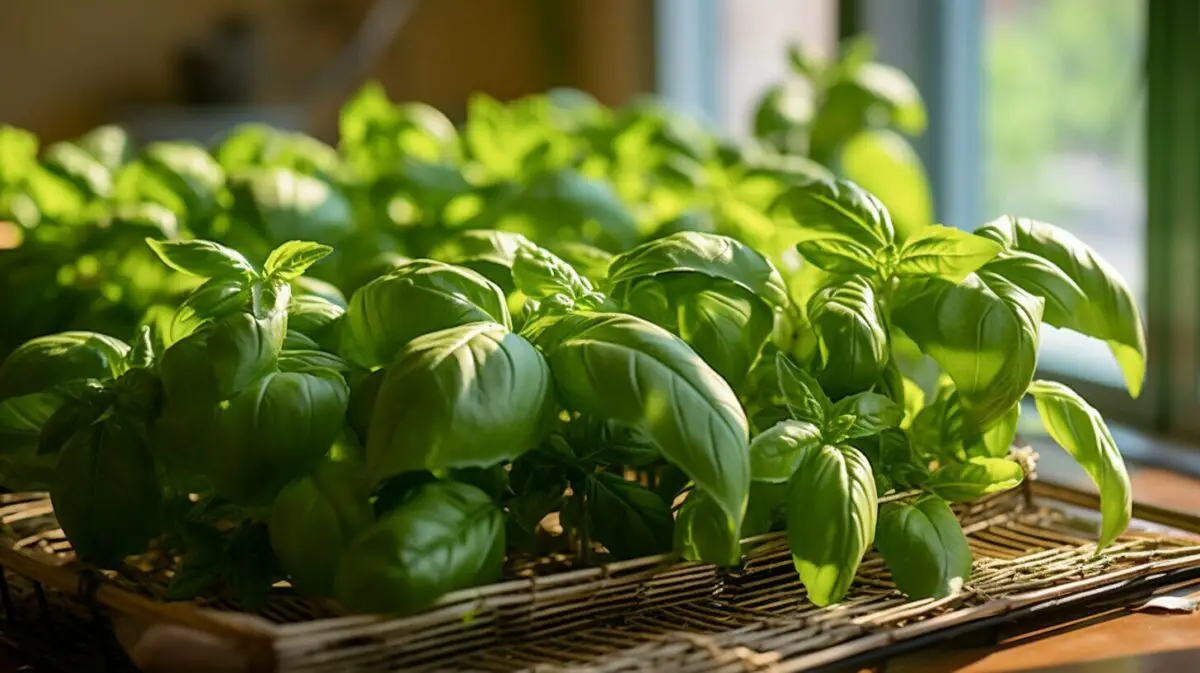
The Importance of Proper Drying
Properly dried basil leaves are the key to a high-quality basil oil. By removing excess moisture, you ensure that the oil is not diluted and that the blend will have a more intense flavor. The drying process also helps to retain the bright green color of the basil leaves, making the oil visually appealing as well.
Here are some tips for effective drying:
- Use a soft cloth or paper towels to gently pat the basil leaves dry.
- Spread the leaves in a single layer to allow air circulation.
- Avoid exposing the leaves to direct sunlight, as it can cause them to wilt or lose their vibrant color.
- Leave the leaves to dry completely before blending with the oil, as any residual moisture can shorten the shelf life of the basil oil.
Table: Guide to Drying Basil Leaves
| Step | Description |
|---|---|
| 1 | After blanching, drain the basil leaves thoroughly. |
| 2 | Gently pat the leaves dry with a soft cloth or paper towels. |
| 3 | Spread the leaves in a single layer to allow air circulation. |
| 4 | Avoid direct sunlight and let the leaves dry completely. |
By following these steps, you can ensure that your basil oil has a vibrant color, intense flavor, and long shelf life. Properly dried basil leaves will contribute to a high-quality and delicious culinary experience.
Blending the Basil and Oil
Once the basil leaves are dry, it’s time to blend them with a cup of your chosen neutral flavored oil, using either a blender or a food processor. This step is crucial in creating a smooth and flavorful basil oil that can elevate your culinary creations.
Blending the basil and oil together helps to infuse the oil with the aromatic essence of the basil leaves, resulting in a vibrant and fragrant final product. The blender or food processor breaks down the basil leaves, ensuring that every drop of oil is infused with the herb’s natural flavors.
To begin, place the dried basil leaves in the blender or food processor. Then, add a cup of your desired neutral flavored oil, such as grapeseed or canola oil. The neutral flavored oil acts as a canvas, allowing the basil’s distinct taste to shine through without overpowering other ingredients.

Blend the mixture on high speed until the basil leaves are pureed and fully incorporated into the oil. This should take just a few minutes, but it may vary depending on the power of your blender or food processor. Keep blending until you achieve a smooth consistency, free from any large pieces of basil.
Once the blending process is complete, your basil oil is ready to be used in a variety of dishes. The aromatic and flavorful qualities of the oil will enhance the taste of salads, pasta, roasted vegetables, grilled chicken, and more. Get creative and explore the endless culinary possibilities that basil oil has to offer.
Now that you have successfully blended your basil and oil, let’s explore the various ways you can incorporate this delicious condiment into your recipes. Here are a few suggestions to get you started:
- Drizzle basil oil over fresh summer salads for a burst of flavor.
- Add it to marinades for meats or vegetables to infuse them with a delightful herbaceous taste.
- Use basil oil as an ingredient in salad dressings for a unique twist.
- Brush it onto bread before toasting or grilling for a fragrant and delicious aroma.
- Drizzle basil oil over seafood dishes to complement their natural flavors.
- Incorporate it into appetizers or dips for an extra layer of taste.
These are just a few examples of how basil oil can elevate your culinary creations. Don’t be afraid to experiment and discover new ways to infuse your dishes with the delicious essence of basil. Enjoy the journey of exploring the endless possibilities that basil oil brings to your kitchen.
| Basil Oil Recipe | Ingredients |
|---|---|
| Basil Oil |
|
| Instructions |
|
Straining the Basil Oil
For a smoother texture, you can choose to strain the basil oil through a fine mesh sieve or cheesecloth, removing any bits of leftover basil leaves. This step is optional but recommended if you want a pure, velvety consistency. Straining the oil will ensure that it is free from any solid particles and impurities, resulting in a more refined and visually appealing final product.
To strain the basil oil, place a fine mesh sieve or cheesecloth over a clean glass jar or bowl. Slowly pour the prepared basil oil into the sieve or wrap the cheesecloth around the oil and gently squeeze it to let the oil pass through. The sieve or cheesecloth will catch any remaining pieces of basil, resulting in a smooth and clear basil oil.
Once you have strained the oil, discard the solids and transfer the strained basil oil into a clean and airtight container. Seal the container tightly to preserve the freshness and flavor of the oil. The strained basil oil is now ready to be used in a variety of culinary creations, adding a burst of basil-infused goodness to your dishes.

| Benefits of Straining | Method |
|---|---|
| Removes solid particles and impurities | Fine mesh sieve or cheesecloth |
| Creates a smooth and visually appealing basil oil | |
| Enhances the overall texture and mouthfeel of dishes |
Seasoning to Taste
To bring out the full flavors of the basil oil, season it with a pinch of salt to taste. Salt acts as a natural enhancer, balancing the herbaceous notes of the basil and adding depth to the overall flavor profile. By carefully adjusting the salt content, you can tailor the basil oil to your personal preferences, ensuring each dish you create with it is perfectly seasoned.
When seasoning the basil oil, start with a small amount of salt and gradually taste and adjust as needed. Remember, it’s easier to add more salt than to remove it, so take it slow. You can sprinkle the salt directly into the blender or food processor while blending the basil and oil together. This allows the salt to distribute evenly throughout the mixture, ensuring each spoonful of basil oil is perfectly seasoned.
Once you’ve achieved the desired level of saltiness, give the basil oil a final taste test. The flavors should be well-balanced, with the salt enhancing the natural herbaceousness of the basil without overpowering it. Trust your taste buds and make any necessary adjustments to achieve the perfect seasoning for your basil oil.
Table: Basil Oil Seasoning Guide
| Amount of Basil Oil (in cups) | Pinch of Salt (in teaspoons) |
|---|---|
| 1 | 1/4 |
| 2 | 1/2 |
| 3 | 3/4 |
| 4 | 1 |
Use this handy table as a general guideline for seasoning your basil oil. The amounts mentioned are approximate, so feel free to adjust according to your taste preferences. Remember, a little salt goes a long way, so start with a small pinch and increase gradually until you reach your desired level of seasoning.
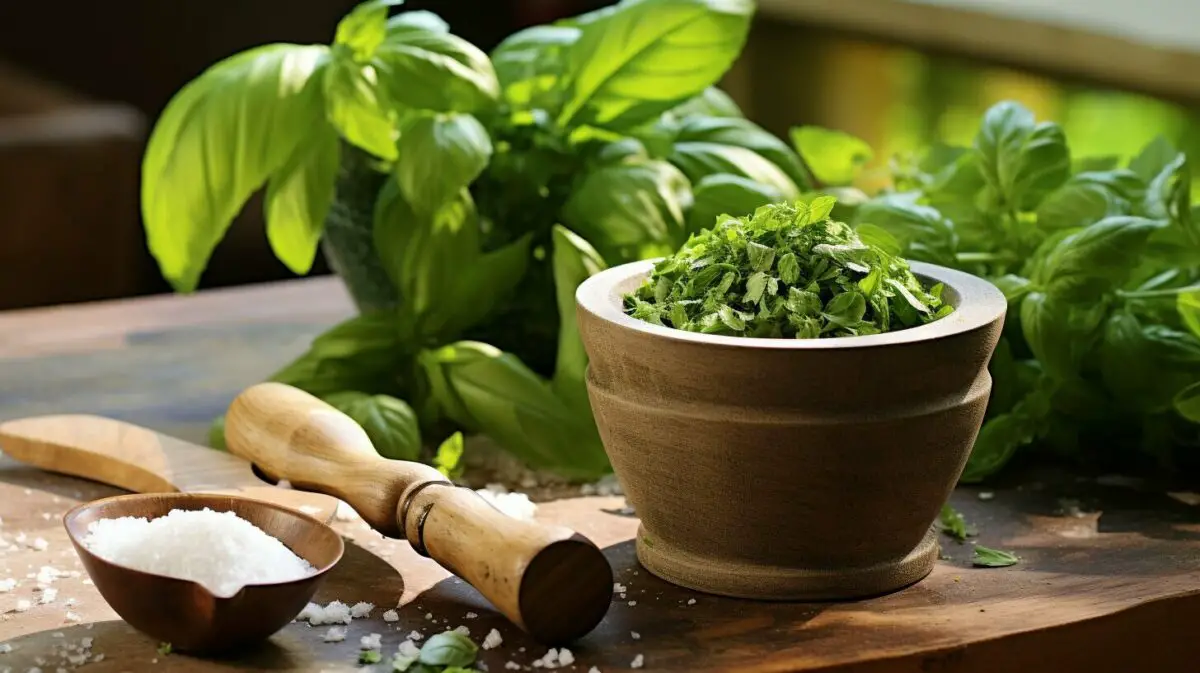
Once you’ve made your delicious basil oil, store it in a sealed container in the refrigerator, where it can last for up to 1-2 weeks. This ensures that you can enjoy the vibrant flavors of basil in your cooking for an extended period of time. The cool temperature of the refrigerator helps to preserve the freshness and quality of the oil, maintaining its aromatic properties.
When storing basil oil, it is important to choose a container that is airtight and opaque. This helps to protect the oil from light and oxygen, which can cause it to deteriorate more quickly. If possible, opt for a dark glass bottle or jar to further shield the oil from light exposure.
Before using the basil oil, give it a gentle shake or stir to remix any separated ingredients. This will ensure that you get the full flavor and aroma of the basil in every use. Remember that the longer you store the basil oil, the more the flavors will develop and intensify, so be sure to adjust the seasoning accordingly when using it in your recipes.
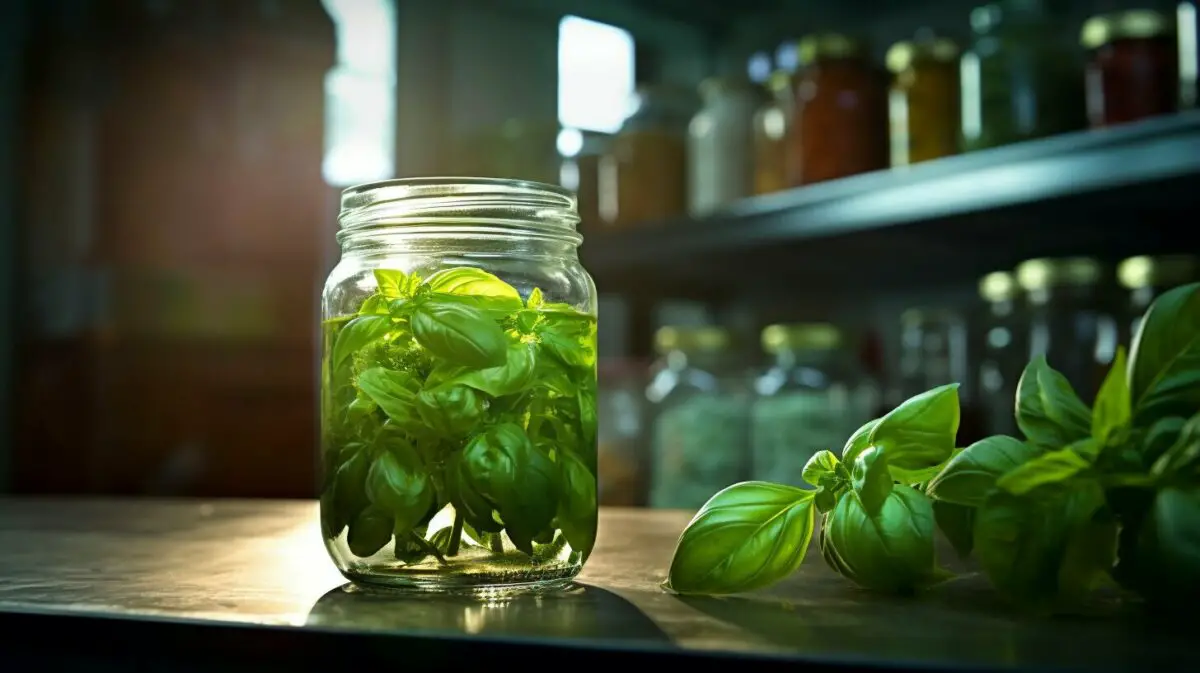
| Tip | Description |
|---|---|
| Use airtight containers | Choose containers that seal tightly to prevent air from entering and spoiling the basil oil. |
| Store in the refrigerator | Keep the basil oil in the refrigerator to maintain its freshness and prolong its shelf life. |
| Keep away from light | Store the basil oil in an opaque container or wrap it in foil to protect it from light exposure. |
| Check for rancidity | Before using the oil, check for any signs of rancidity, such as a strong off odor or a bitter taste. |
With these storage tips, you can ensure that your homemade basil oil remains flavorful and ready to enhance your favorite dishes. So go ahead and savor the taste of summer all year round with your very own basil oil!
Endless Culinary Possibilities
With your homemade basil oil in hand, you can unlock a world of culinary possibilities, adding a burst of fresh flavor to summer salads, pasta dishes, roasted vegetables, grilled chicken, and many other delectable creations. The versatility of basil oil makes it a must-have ingredient in any kitchen, offering a unique twist to familiar recipes and inspiring new culinary adventures.
Imagine drizzling a vibrant green basil oil over a refreshing tomato and mozzarella salad, elevating its taste to a whole new level. Or tossing hot pasta with a generous amount of basil oil, infusing it with the essence of fresh herbs. Roasted vegetables become even more irresistible when coated with a flavorful basil oil, and grilled chicken takes on a whole new dimension when brushed with this aromatic delight.
Not only does basil oil enhance the flavor of dishes, but it also adds a touch of elegance and sophistication to your culinary creations. Its vibrant color and aromatic profile make it a perfect finishing touch, whether you’re garnishing a soup or dressing up a simple appetizer. The possibilities are truly endless when it comes to incorporating basil oil into your cooking.
| Recipes to Try with Basil Oil |
|---|
| Caprese Salad |
| Garlic and Basil Pasta |
| Roasted Vegetable Medley |
| Grilled Lemon Basil Chicken |
So, why not embark on a culinary journey with basil oil? Experiment with different flavors, explore new combinations, and let your creativity soar in the kitchen. With a simple drizzle or a hearty infusion, basil oil will transform your dishes into masterpieces, leaving your taste buds craving for more.

- Add a drizzle of basil oil to fresh summer salads for a burst of herbaceous flavor.
- Toss pasta with basil oil for a quick and delicious meal.
- Brush grilled vegetables with basil oil for a flavorful and vibrant side dish.
- Marinate chicken in basil oil for a juicy and aromatic main course.
- Infuse bread with basil oil for a unique and fragrant accompaniment to any meal.
- Enhance the flavors of seafood dishes with a touch of basil oil.
- Create mouthwatering appetizers by drizzling basil oil over crostini or bruschetta.
Health Benefits of Basil Oil
Not only does basil oil elevate the taste of your dishes, but it also offers numerous health benefits, making it an essential ingredient for both delicious and healthy recipes. Basil oil is known to have antioxidant and anti-inflammatory properties, which can help support a healthy immune system and reduce the risk of chronic diseases.
Basil oil contains essential oils such as eugenol, which has been shown to have antimicrobial properties that may help fight against bacterial and fungal infections. Additionally, basil oil is rich in vitamins A, C, and K, as well as minerals like calcium, magnesium, and potassium, which are essential for maintaining overall health.
Incorporating basil oil into your cooking can also contribute to improved digestion. The volatile oils in basil can stimulate the production of digestive enzymes, aiding in the breakdown and absorption of nutrients. This can help alleviate digestive issues such as bloating and indigestion.
To reap the health benefits of basil oil, try using it in a variety of recipes, from salad dressings to marinades. Its delicate herbal aroma and fresh flavor will not only enhance the taste of your dishes but also provide a boost of nutritional value. So, get creative in the kitchen and enjoy the many healthy advantages of basil oil!

| Health Benefits of Basil Oil | Summary |
|---|---|
| Antioxidant and Anti-inflammatory Properties | Supports a healthy immune system and reduces the risk of chronic diseases. |
| Antimicrobial Properties | Helps fight against bacterial and fungal infections. |
| Rich in Essential Vitamins and Minerals | Provides important nutrients for overall health. |
| Aids Digestion | Stimulates the production of digestive enzymes for better nutrient absorption. |
Creative Ways to Use Basil Oil
Experiment with the versatility of basil oil by drizzling it over fresh salads, adding it to marinades, infusing it into dressings, or using it to flavor bread, seafood, and appetizers. The aromatic and vibrant flavors of basil oil can elevate any dish, adding an extra dimension of taste and sophistication.
One delicious way to use basil oil is by drizzling it over a crisp and refreshing summer salad. The fragrant basil notes complement the fresh greens and vegetables, creating a delightful combination of flavors. For a burst of freshness, try adding a few drops of basil oil to your marinades, allowing it to infuse the meat or vegetables with its aromatic essence.
Infusing basil oil into dressings is another creative way to enhance your culinary creations. Simply whisk together your favorite vinegar, olive oil, and a few drops of basil oil for a vibrant and flavorful dressing. You can also use basil oil to add a burst of flavor to homemade bread. Just brush some basil oil onto the dough before baking, and enjoy the aromatic result.
Seafood and appetizers can also benefit from the addition of basil oil. Drizzle it over grilled shrimp or salmon to add a touch of freshness and elevate the dish to new heights. For appetizers, serve a crusty baguette alongside a dish of basil oil for dipping. Your guests will be impressed by the unique and delicious flavor combination.
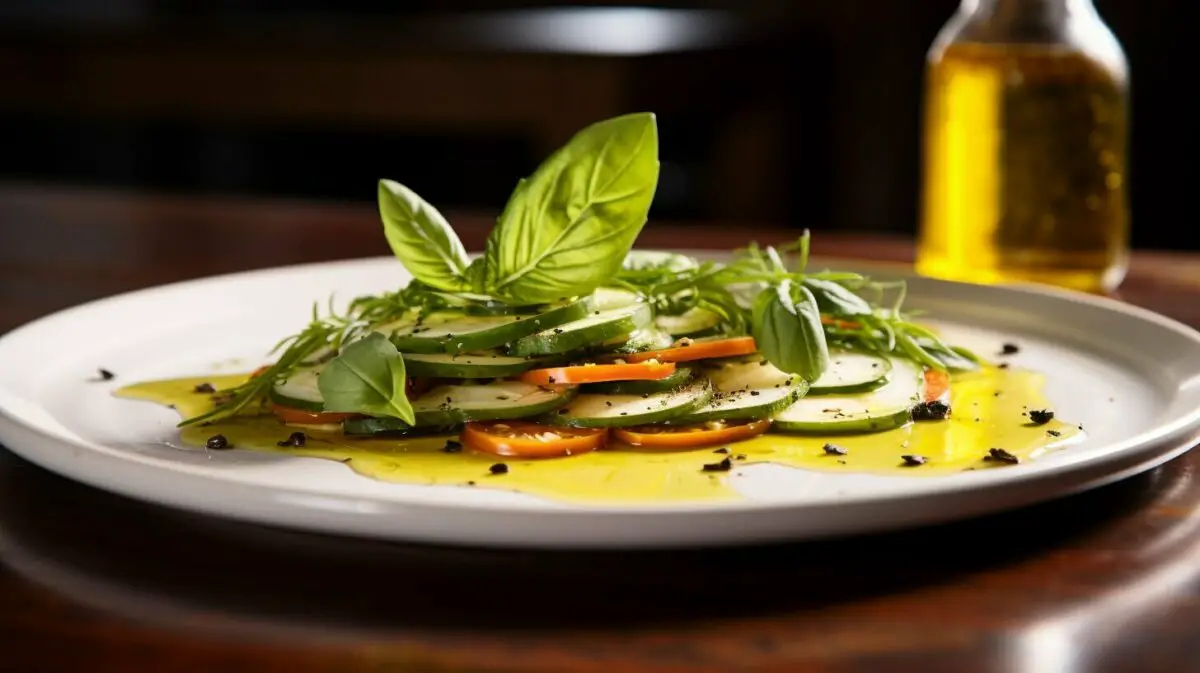
| Ways to Use Basil Oil | Recipe Ideas |
|---|---|
| Drizzle over salads | Arugula and Watermelon Salad with Basil Oil Dressing |
| Add to marinades | Grilled Lemon-Basil Chicken Skewers |
| Infuse into dressings | Caprese Salad with Basil Oil Vinaigrette |
| Flavor bread | Focaccia with Basil Oil and Sea Salt |
| Drizzle over seafood | Grilled Shrimp with Basil Oil |
| Use for appetizers | Basil Oil Dipping Sauce for Crostini |
Aromatic Companions: Vinegars and Extracts
Take your culinary creations to the next level by exploring the world of aromatic companions, such as basil-infused vinegars and extracts. These flavorful additions can elevate your dishes and add a unique twist to your recipes. Let’s dive into the possibilities and discover how to incorporate these aromatic companions into your cooking adventures.
Starting with basil-infused vinegars, these tangy and vibrant liquids are created by infusing basil leaves into vinegar. The process involves combining fresh basil leaves with vinegar and allowing them to steep for a period of time. The result is a vinegar with a subtle basil essence that can be used in dressings, marinades, or even as a drizzle over roasted vegetables. The acidity of the vinegar complements the herbaceous notes of basil, creating a delightful balance of flavors.
Another aromatic companion worth exploring is basil extract. Extracts are concentrated forms of flavor, extracted from various ingredients. Basil extract captures the essence of basil in a convenient form that can be easily incorporated into your recipes. Just a few drops of basil extract can add a burst of basil flavor to sauces, soups, or even baked goods. It’s a versatile ingredient that can be used sparingly to enhance the taste of your dishes.
Table: Basil-Infused Vinegars vs. Basil Extract
| Basil-Infused Vinegars | Basil Extract |
|---|---|
| Created by steeping basil leaves in vinegar | A concentrated form of basil flavor |
| Tangy and vibrant, adds depth to dressings and marinades | Intense basil flavor in just a few drops |
| Perfect for drizzling over roasted vegetables | Enhances the taste of sauces, soups, and baked goods |
By exploring the world of aromatic companions, such as basil-infused vinegars and extracts, you can add a new dimension to your culinary creations. Whether you prefer the tanginess of vinegar or the concentrated flavor of extracts, these aromatic companions will surely delight your taste buds. Get creative in the kitchen and experiment with different combinations to discover your own signature dishes. Infuse your cooking with the enticing aroma and taste of basil, and let your culinary journey begin.
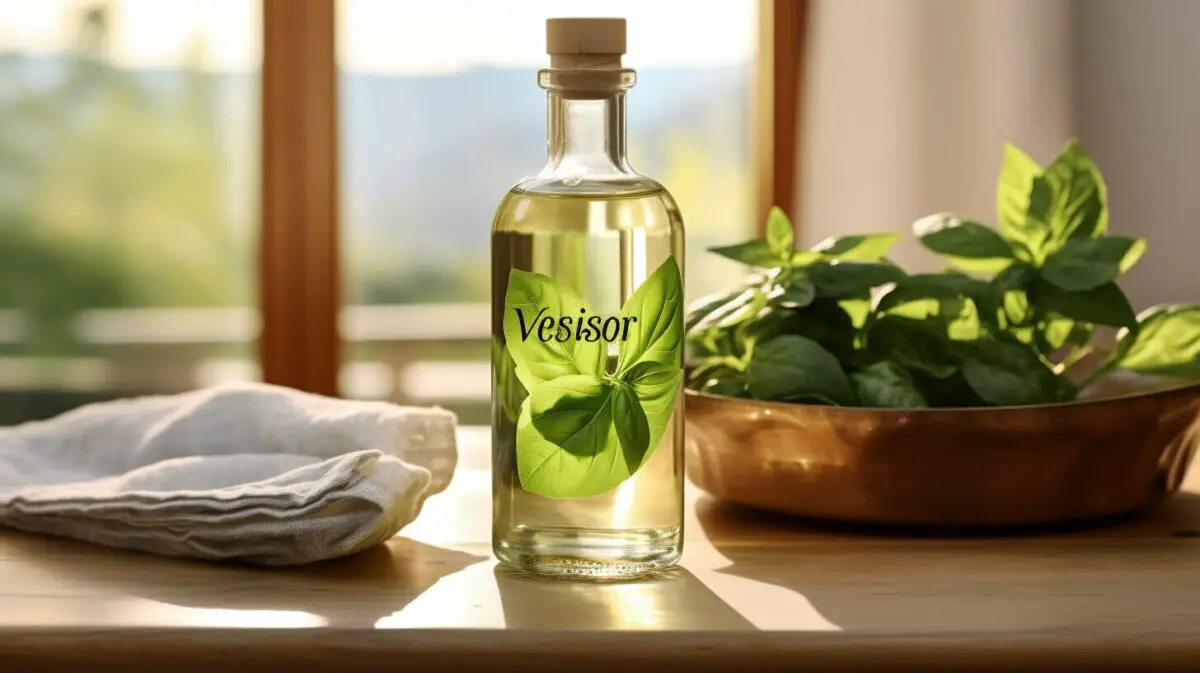
Basil Oil in Cooking Techniques
Incorporate basil oil into various cooking techniques, from sautéing vegetables to creating emulsions or infusing it into herb oils, flavored oils, or aromatized oils. Basil oil adds a burst of fresh flavor to your culinary creations, elevating them to new heights. Whether you’re looking to enhance the taste of sautés, create vibrant herb-infused oils, or add complexity to your favorite dishes, basil oil is a versatile ingredient that can take your cooking to the next level.
When sautéing vegetables, drizzle a little basil oil into the pan to infuse them with a fragrant herbaceousness. The heat will release the aromatic compounds in the oil, enhancing the flavors of the vegetables and adding depth to the dish. You can also use basil oil to create emulsions, like homemade mayonnaise or vinaigrettes. Its smooth texture and rich flavor will give your dressings and sauces a delicious twist.
If you’re feeling adventurous, try infusing basil oil into other oils. By combining basil oil with different herbs or spices, you can create your own personalized herb oils, flavored oils, or aromatized oils. Use them to drizzle over salads, toss with pasta, or brush onto grilled meats for a burst of vibrant flavor. The possibilities are endless, and the results are sure to impress your taste buds.
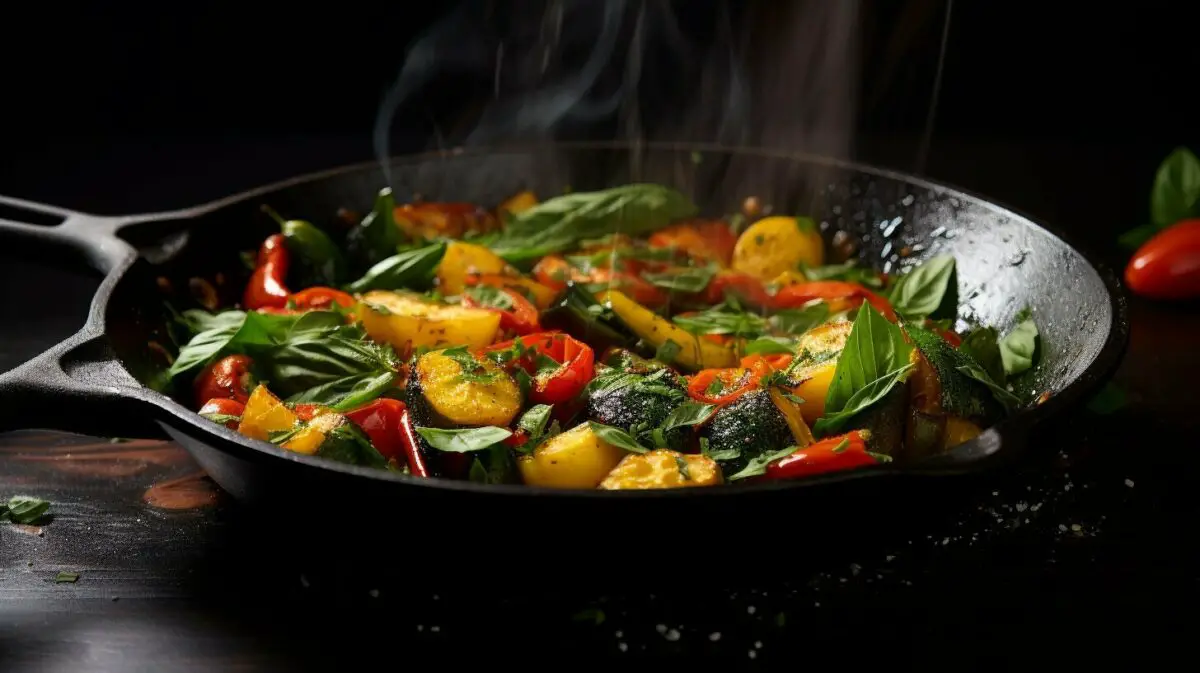
- Start with a small amount and add more as needed. Basil oil is potent, so a little goes a long way.
- Experiment with different herbs and spices to create your own unique infused oils.
- Store basil oil in a cool, dark place to preserve its freshness and flavor.
- Consider using basil oil as a finishing touch to drizzle over dishes just before serving for an extra burst of flavor.
By incorporating basil oil into your cooking techniques, you can add a touch of freshness and complexity to your dishes. Whether you’re sautéing, creating emulsions, or infusing oils, basil oil is a versatile ingredient that can take your culinary creations to new heights. So don’t be afraid to get creative in the kitchen and explore the endless possibilities of basil oil.
| Basil Oil in Cooking Techniques | Benefits |
|---|---|
| Sautéing | Enhances flavors and adds a fragrant herbaceousness to vegetables |
| Emulsions | Creates creamy dressings and sauces with a burst of fresh basil flavor |
| Infused Oils | Allows you to customize your own herb oils, flavored oils, or aromatized oils |
Elevating Your Culinary Journey
Broaden your culinary horizons by using basil oil for marinating, seasoning, finishing, garnishing, blending, steeping, infusing, macerating, soaking, coating, basting, and brushing. With its vibrant flavor and aromatic qualities, basil oil can transform ordinary dishes into extraordinary culinary creations.
Marinating: Infuse your favorite meats, seafood, or vegetables with the essence of basil by adding a splash of basil oil to your marinade. Let it sit for a few hours or overnight to allow the flavors to meld together, resulting in a tender and flavorful dish.
Seasoning: Drizzle basil oil over salads, roasted vegetables, or grilled meats to add a burst of freshness and complexity. Its herbaceous notes will enhance the overall taste of your dishes and make them more visually appealing.
Finishing and Garnishing: Add a finishing touch to your creations by drizzling basil oil on top of soups, pasta, or grilled bread. The vibrant green color and aromatic flavor will elevate the presentation and taste of your dishes, impressing both your palate and guests.
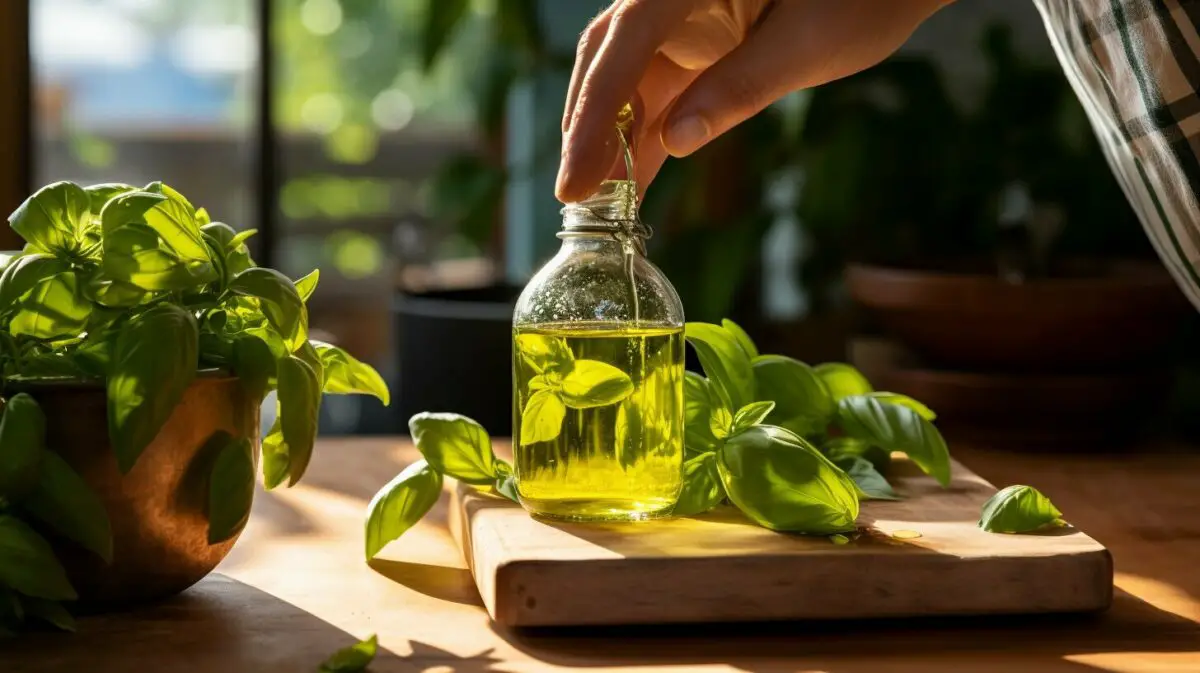
Blending and Infusing: Incorporate basil oil into your homemade dressings, sauces, or pesto to intensify the basil flavor and create a unique taste profile. Use it as a base for vinaigrettes or blend it with other ingredients like garlic or lemon juice to unleash a harmonious blend of flavors.
Table: Ideas for Using Basil Oil
| Usage | Ideas |
|---|---|
| Marinating | Chicken, shrimp, tofu |
| Seasoning | Salads, roasted vegetables, grilled meats |
| Finishing and Garnishing | Soups, pasta, grilled bread |
| Blending and Infusing | Dressings, sauces, pesto |
“Basil oil adds an unrivaled depth of flavor and freshness to my dishes. It’s become a staple ingredient in my kitchen, allowing me to explore new culinary boundaries.” – Chef Jessica Adams
With basil oil in your culinary arsenal, you can unlock a world of creative possibilities. Experiment with different techniques, explore new flavors, and let your imagination run wild. Whether you’re marinating meats, finishing a dish, or garnishing with flair, basil oil will take your cooking to new heights.
How to Make Basil Oil – Conclusion
Congratulations! You’ve learned how to make basil oil from scratch and discovered its incredible potential to elevate your culinary creations. With just a few simple steps, you can now embark on a flavor-rich journey and unlock a world of delectable possibilities in your kitchen.
To make basil oil, start by blanching fresh basil leaves in boiling water for 10-15 seconds, then transfer them to an ice water bath to retain their vibrant green color and fresh flavor. After draining and patting them dry, blend the basil leaves with 1 cup of neutral flavored oil, such as grapeseed or canola oil, until pureed.
You can use the basil oil as is or strain it through a fine mesh sieve or cheesecloth to achieve a smoother consistency. Remember to season the oil with salt to taste, enhancing its flavors and tailoring it to your personal preference. Store the basil oil in the refrigerator, where it can stay fresh for 1-2 weeks.
Now that you have your homemade basil oil, the possibilities are endless. Drizzle it over salads, add it to marinades, infuse it into dressings, use it to flavor bread, seafood, and appetizers – let your creativity soar. Basil oil can also be combined with vinegars, extracts, and other infusions to create aromatic companions. Additionally, explore the various cooking techniques where basil oil can be utilized, such as sautéing, emulsions, and creating herb-infused, flavored, or aromatized oils.
FAQ – How to Make Basil Oil
Q: How do I make basil oil?
A: To make basil oil, blanch fresh basil leaves in boiling water for 10-15 seconds, then transfer them to an ice water bath. Drain and pat them dry. Place the basil in a blender with 1 cup of neutral flavored oil, such as grapeseed or canola oil. Blend until pureed. You can strain the oil through a fine mesh sieve or cheesecloth if desired. Season with salt to taste. Store the basil oil in the refrigerator for 1-2 weeks.
Q: What ingredients do I need to make basil oil?
A: You will need fresh basil leaves and a blender or food processor. Additionally, you can use neutral flavored oil, such as grapeseed or canola oil, and season the oil with salt to taste.
Q: How long can I store basil oil?
A: Basil oil can be refrigerated for 1-2 weeks.
Q: What can I use basil oil for?
A: Basil oil can enhance the flavor of various dishes, including summer salads, pasta, roasted vegetables, grilled chicken, and more. It can be used as a drizzle, added to marinades, infused into dressings, or used to flavor bread, seafood, and appetizers.
Q: Are there any health benefits associated with basil oil?
A: Basil oil may have potential health benefits and can contribute to delicious and healthy recipes. It can also enhance the cooking experience.
Source Links
- https://www.prouditaliancook.com/2013/08/making-basil-oil.html?m
- https://blog.mountainroseherbs.com/essential-oil-conversions
- https://thefoodiephysician.com/the-doctor-is-in-kitchen-q-basil-oil/
Related Recipes:
 How to Air Fry Any Vegetable? (Perfect Step-By-Step Guide)
How to Air Fry Any Vegetable? (Perfect Step-By-Step Guide)
 How to Flavor Kefir? (Perfect Step-By-Step Guide)
How to Flavor Kefir? (Perfect Step-By-Step Guide)
 How to Freeze Spinach? (Perfect Step-By-Step Guide)
How to Freeze Spinach? (Perfect Step-By-Step Guide)
 How to Cook Nopales? (Perfect Step-By-Step Guide)
How to Cook Nopales? (Perfect Step-By-Step Guide)
 How to Cook Asparagus? (5-Way Step-By-Step Guide)
How to Cook Asparagus? (5-Way Step-By-Step Guide)
 How to Make Chard Wraps? (Perfect Every Time!)
How to Make Chard Wraps? (Perfect Every Time!)
 Mastering the Kitchen: What are the 5 Basic Cooking Skills?
Mastering the Kitchen: What are the 5 Basic Cooking Skills?
 How to Cook Black Beans? (Perfect Step-By-Step Guide)
How to Cook Black Beans? (Perfect Step-By-Step Guide)








